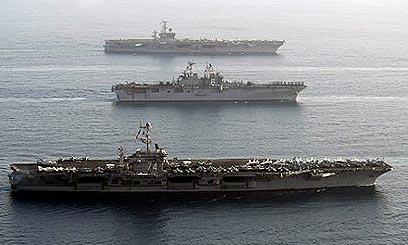
US war game simulates aftermath of Israeli strike on Iran
NYT: 'Internal Look' simulation assesses American capabilities should Israel carry out a strike against Iran. Results: Disastrous regional war
The officials who either participated in the Central Command exercise or who were briefed on the results spoke on condition of anonymity because of its classified nature. They noted that General Mattis told aides that an Israeli first strike would be likely to have dire consequences across the region and for US forces there.
Related stories:
- 'Israel must show sensitivity to US reality over Iran strike'
- Lieberman: War with Iran a global nightmare
- Op-ed: Iran strike a death wish
The New York Times added that the game called Internal Look, which lasted for two weeks, played out a narrative in which the United States found it was pulled into the conflict after Iranian missiles struck a Navy warship in the Persian Gulf, killing about 200 Americans. The United States then retaliated by carrying out its own strikes on Iranian nuclear facilities.

US military maneuvers in Persian Gulf
The US officials stressed that the so-called war game was not designed as a rehearsal for American military action — and they emphasized that the exercise’s results were not the only possible outcome of a real-world conflict.
Yet they said that the game raised fears among top American planners that it may be impossible to preclude American involvement in any escalating confrontation with Iran.
In planning the war game scenarios the Americans assessed that the Israeli preventative strike set back the Iranian nuclear program by a year, and that the subsequent American strikes did not slow the Iranian nuclear program by more than an additional two years.
The article claims that the exercise was designed specifically to test internal military communications and coordination among battle staffs in the Pentagon, Central Command and the Persian Gulf in the aftermath of an Israeli strike.
No full out war
Internal Look war games take place twice a year and have long been one of Central Command’s most significant planning exercises. Over the years, they have been used to prepare for various wars in the Middle East, including the invasion of Iraq in 2002.
In the end, officials told the paper "the war game reinforced to military officials the unpredictable and uncontrollable nature of a strike by Israel, and a counterstrike by Iran."
American and Israeli intelligence services broadly agree on the progress Iran has made to enrich uranium. But they disagree on how much time there would be to prevent Iran from building a weapon if leaders in Tehran decided to go ahead with one.
Some military specialists in the US and in Israel believe that the last thing Iran would want is a full-scale war on its territory. They argue that Iran would not directly strike American military targets, whether warships in the Persian Gulf or bases in the region.
Their analysis, however, also includes the broad caveat that it is impossible to know the internal thinking of the senior Iranian leadership, and is informed by the awareness that even the most detailed war games cannot predict how nations and their leaders will react in the heat of conflict.
Yitzhak Benhorin in Washington contributed to the report
- Receive Ynetnews updates directly to your desktop










